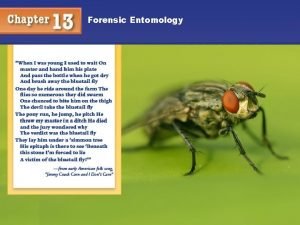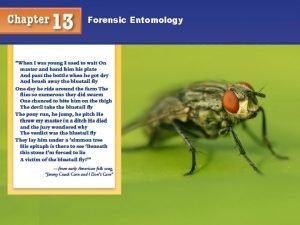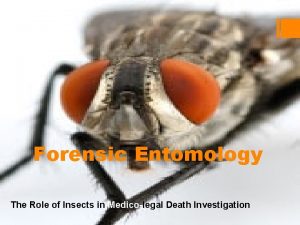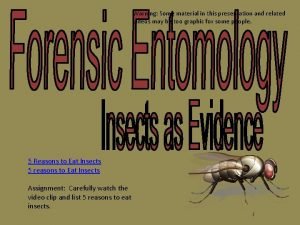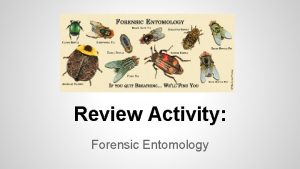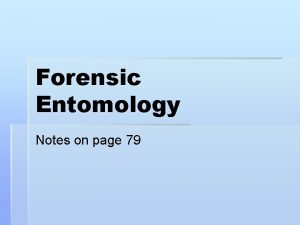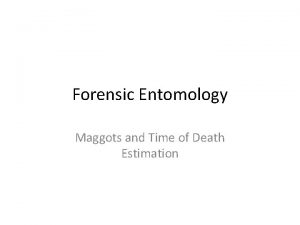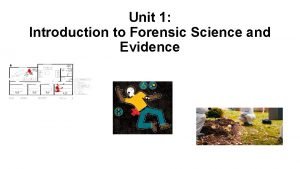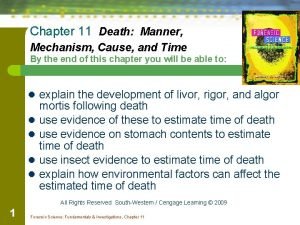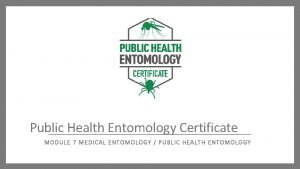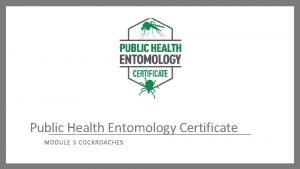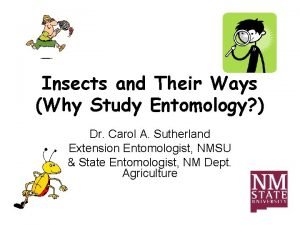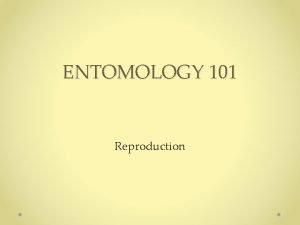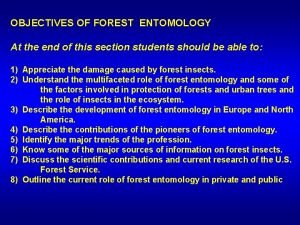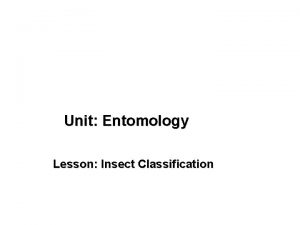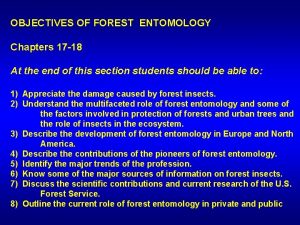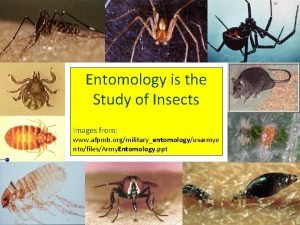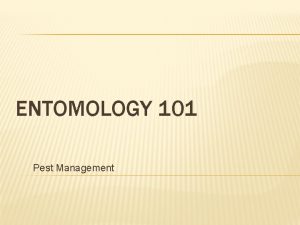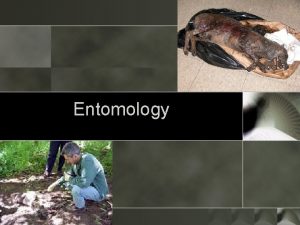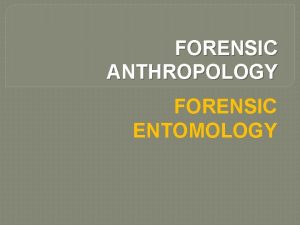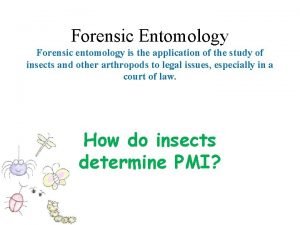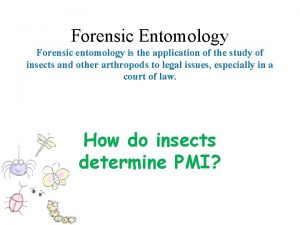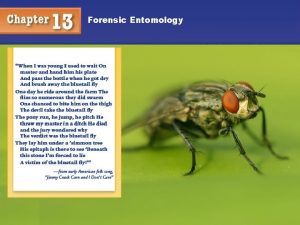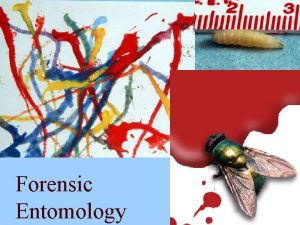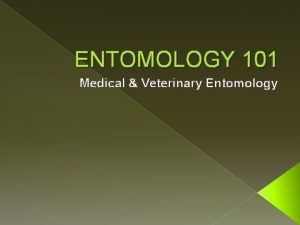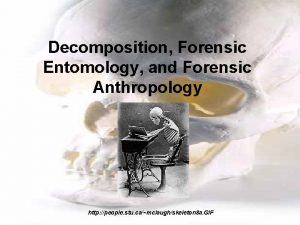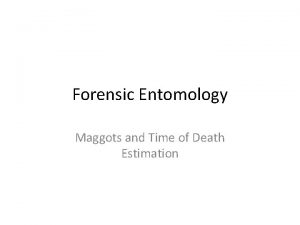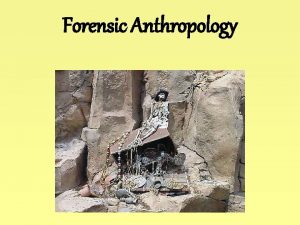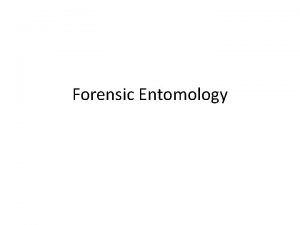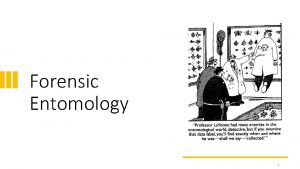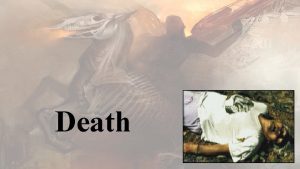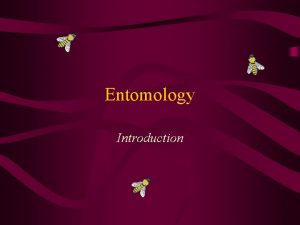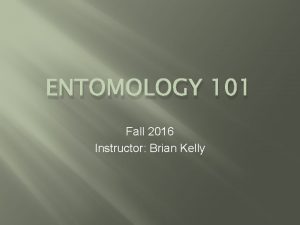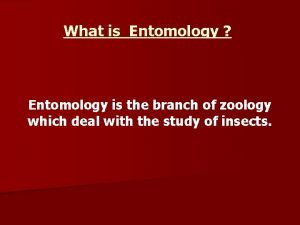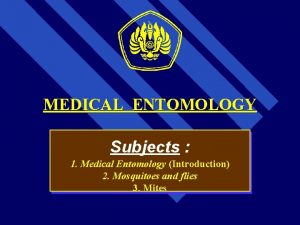THE PROCESS OF DEATH AND FORENSIC ENTOMOLOGY The




























- Slides: 28

THE PROCESS OF DEATH AND FORENSIC ENTOMOLOGY

The Process of Death • Pathologist determines time of death • Pretty accurate if body found within first 24 hours after death using the following indicators: – Algor mortis – cooling rate of body after death – Livor mortis – pooling of blood due to gravity after heart stops – Rigor mortis – rigidity of muscles after death

Algor Mortis • • Cooling rate of body Starting temp = 98. 6 degrees Begins equalizing temp of environment Glaister Equation: used between 1 and 36 hours since death, most accurate within first 12 h to determine time period since death based on body temperature Hours since death = 98. 4°F – internal body temp 1. 5

Must also consider: • Temperature of environment • Type and layers of clothing on body • Wetness of clothing • Air movement • The greater the surface area to mass ratio – body cools faster – e. g. children, small adults

Livor Mortis • • • “lividity” – discoloration; black and blue Pooling of blood due to gravity after heart stops Appears as purplish-red discoloration Indicates position of body at time of death Doesn’t occur in areas of body that are in contact with ground or constricted by other objects • Begins within ½ h. after death and most evident within first 12 h. • Used to determine if body has been moved after death

Livor Mortis

Rigor Mortis • Upon death muscles relax, ATP breaks down and muscles become rigid • Smaller muscles first (face, neck, jaw) • Occurs within few hours of death and is gone within ~30 h – then body becomes limp • Not 100% accurate - must consider: – Environmental temp – Dehydration – Muscle condition and their use before death

Rule of thumb in estimating time of death Temp of body Stiffness of body Time since death Warm Not stiff Not dead more than 3 h Warm Stiff Dead between 3 and 8 h Cold Stiff Dead between 8 and 36 h cold Not stiff Dead more than 36 h

Stages of Decomposition 1. 2. 3. 4. 5. Autolysis Putrefaction Black putrefaction Butyric fermentation Diagenesis

Autolysis • 0 -4 days • appears fresh externally, but decomposing internally • Cells self-destruct due to no oxygen, increase in carbon dioxide, decrease in p. H, and wastes accumulating • After a few days fluid-filled blisters appear and skin sloughs off

Putrefaction • 4 -10 days • Soft tissues are destroyed by bacteria • Bacteria give off gases - bloating • Greenish skin • Horrible smells

12

Black Putrefaction • 10 -20 days • Body is mass of fluids • Collapses as gases escape • Flesh creamy but exposed body parts black • Horrible smells • Fluids drain out of body

14

Butyric Fermentation • 20 -50 days • Cadaver is drying out • Some flesh remains • Butyric acid – cheesy odor

Adipocere formation • Months to years after death • Yellowish-white, greasy wax-like substance • Forms as a result of the breakdown of fatty acids by a particular anaerobic bacterium • Occurs when: – Burial in moist, alkaline soild – High body fat of corpse – Burial in a casket within a vault

Saponification - “soap making” 17

Diagenesis • • 50 -365 days Dry decay May mummify Bone is altered

Rough estimate – depends on temperature, moisture, scavengers, etc. #days to become skeletonized = 1285 avg temp °C So if a body is left in 20 C (68 F) it would take about 64 days for it to become skeletonized

Taxonomy • Classification system • Carolus Linnaeus (1707 -1778) • • Kingdom Phylum Class Order Family Genus Species

Palmetto Bug • Kingdom Animalia • Phylum Arthropoda • Class Insecta • Order Blattodea • Family Blattidae • Genus Eurycotis • Species Eurycotis floridana

Three ways Entomology is used in Forensics 1. Urban entomology – affecting man and his environment (e. g. termite damage to a building) 2. Stored products entomology – insects infecting food 3. Medical Entomology – insects that inhabit human remains

Medical Entomology • Deals with necrophagous insects – eat carrion (carcass of dead, decaying animal) • Dermestidae - family • Insects determine PMI – postmortem interval – time that has elapsed since a person died Carrion beetle


Insects of Death • Flies (Order Diptera) • Beetles (Coleoptera) • Some eat flesh, some eat other species of larvae (beetle or fly) on the flesh • Some rural, some urban • Some shade, some sun • Some nocturnal (usually beetles)

Red-legged Ham beetle Hister beetle

Other uses of insects • Presence of wounds – if maggots found on torso rather than in mouth, nose etc. • Place suspect at crime scene – e. g. if murder suspect had chigger bites and chiggers found to only be in that one area • Contraband trafficking may contain insects - can determine where it came from • Insects on front of a car may indicate where a person has been • Presence of drugs in a body may be detected by presence of drugs in maggots

Insect development depends on: • • Temperature Higher temp = faster growth Requires a certain temp range – not too hot, not too cold Growth rate in temp-time units = degree-days or degreehours. Represent amt of heating/cooling needed to go from one stage to next (e. g. egg to second instar)
 Forensic entomology equipment
Forensic entomology equipment Forensic entomology examples
Forensic entomology examples Medicolegal forensic entomology
Medicolegal forensic entomology Crime solving insects case studies answers
Crime solving insects case studies answers Adh forensics formula
Adh forensics formula Forensic entomology
Forensic entomology Maggots
Maggots How to calculate adh forensics
How to calculate adh forensics Forensic entomology does not include _____.
Forensic entomology does not include _____. Pro corbis
Pro corbis Chapter 11 forensic entomology
Chapter 11 forensic entomology Pathologist and anthropologist
Pathologist and anthropologist Forensic psychiatry vs forensic psychology
Forensic psychiatry vs forensic psychology Public health entomology certificate
Public health entomology certificate Cockroach life cycle stages
Cockroach life cycle stages Whats the definition of main idea
Whats the definition of main idea Why study entomology
Why study entomology Oviparity
Oviparity Forest entomology definition
Forest entomology definition Branches of entomology
Branches of entomology Complete metamophosis
Complete metamophosis Father of forest entomology
Father of forest entomology Crime solving insects reference card
Crime solving insects reference card Entomology 101
Entomology 101 Adh forensics
Adh forensics Entomology is the study of
Entomology is the study of Forensic pathology examples
Forensic pathology examples Embedded markov chain
Embedded markov chain Chapman kolmogorov equation
Chapman kolmogorov equation
